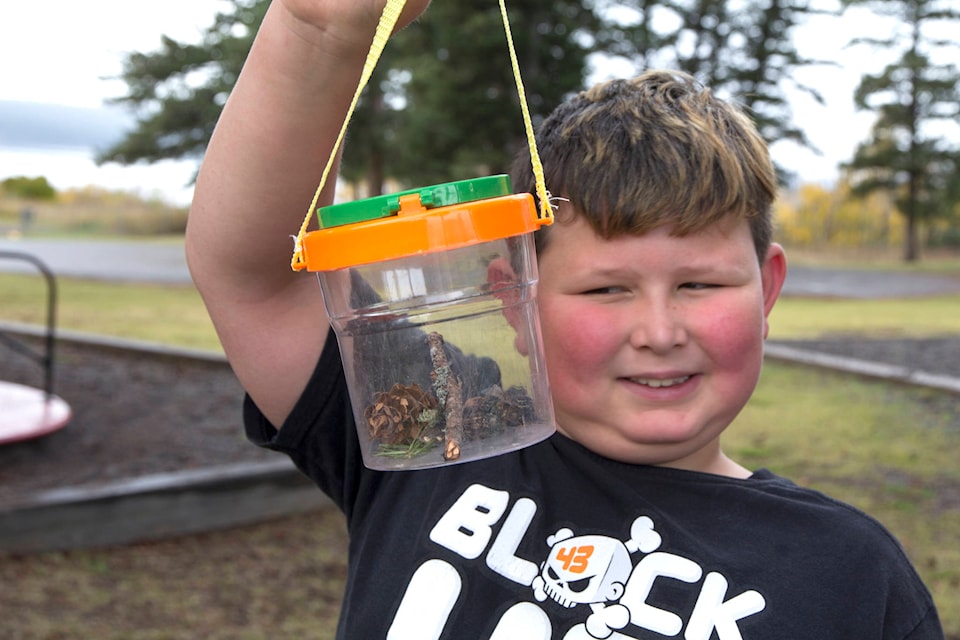Carrying plastic containers and clutching manila folders, students at Lac La Hache elementary slip outside for the last class of the day. “Come down to the classroom, please,” teacher Tanya Ilnicki says.
Some take seats on the heavy stumps or stand on the wooden benches facing a green chalkboard. Others mill about, showing off their personal ‘memory keepers’ - collections of sticks, rocks and lichen found on a recent trip into the forest.
The students are part of the Wild School - a free, three-year initiative at Lac La Hache elementary that supports outdoor and place-based learning. The idea is aimed at increasing ecological literacy, outdoor field experiences and building connections to conservation in the community.
“It’s to get the kids outdoors more to respect nature and be active,” Ilnicki said. “Our classroom makes it very easy.”
Indeed, the school backs onto vast forests that the students and teachers have permission to use as part of their studies. Every morning, they go for a walk, run or bike around the schoolyard, while at least one full day a month is spent outdoors.
Last week, for instance, the Grades 3-7 students took a trip to Gavin Lake, where they experienced canoeing, archery and wall-climbing while learning about fish and trout habitat. Earlier this week, they pulled invasive weeds around the school. And on Oct. 21, Wild School facilitators will provide outdoor education to both students and teachers.
The focus this year is on forestry - from the diversity in the woods to inter-related systems, including how animals interact. Principal Kristi Davis said later this fall the students will also return to a burned area where they planted seedlings following the 2017 wildfires. Davis said the visit will allow the students to see how they made a difference as well as gain an understanding of how trees are important for oxygen and the animals living in the woods.
“It’s really good to be getting out in nature and learning about nature,” she said. “A lot of kids don’t get out as much as they used to. It’s to gain an appreciation of the outdoors.”
The students also learn about migration, hibernation and adaptation of animals, as well as Indigenous plants used for centuries by local Indigenous peoples in the area. Outdoor learning can be translated to any class, Davis said. She recently took her students outside to collect and count items to learn about estimating, while the memory keepers were tied into lessons about Orange Shirt Day.
READ MORE: EnGold discovers visible gold at two Lac la Hache sites
The students had read Shi-shi-etko, the book by Nicola Campbell, which tells the story of a little girl who gathered memories from her family before she went away to residential school.
The students were then asked: “If you were taken to residential school what would you take with you or want to remember?”
Sawyer Keddie showed off his container, which included a scrap of lichen “because we learned about lichen” in class and a pinecone that was sitting on the bench next to his friend Marcus Lisoway when they first met. Zion Field, meanwhile, gently held a bird’s nest.
“We found it when we were looking for memories,” Raina Rees, 12 said of the bird’s nest. “There’s big bushes and really cool things. There’s this log that’s been there a very long time - it’s been here as long as I’ve been here.”
Davis said the Wild School, in its second year, is looking to expand its outdoor physical education program. Ten bikes were recently donated by the community and students ride during recess and lunch and sometimes in the morning. The plan is to get enough bikes to use for gym classes. “It’s been proven that being outside in nature is good for your mental health,” she said.
llnicki agreed, saying the teachers are learning just as much as the students. One day, they had a visit from the ‘Bone Detective’ at Scout Island who taught them about skulls. The students also found a big insect that turned out to be some kind of beetle that flies at night.
The school also operates when it snows. But on this day, the students are shuffled back inside once it starts to rain. “What are we doing next?” Anna-May du Ruiter asks. Her friend Marcus responds: “Hibernating?”
newsroom@100milefreepress.net
Like us on Facebook and follow us on Twitter.
